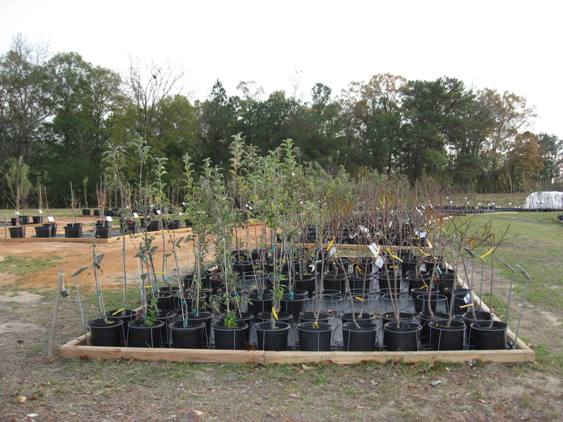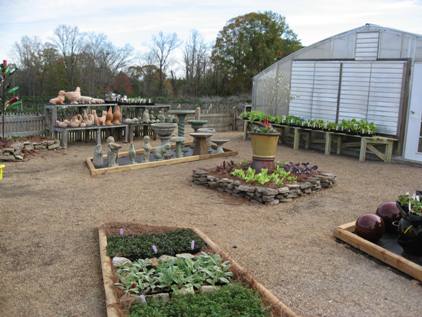Garden Gossip
Petals from the Past
February, 2011
Welcome to our garden! We're proud of our
hard work and want to share the reward with you, so here is what's going on in
the garden this month.....
Central Alabama
Larkspur Plants
|

Red Shirley Poppy Plants |
| Some how the time to plant my larkspur and poppy seeds has slipped away from me and now it is too late. Petals has the solution for that problem. We have plants in 3-paks available now. Get these little plants in the ground right away so they will have a chance to grow and mature before the weather gets to hot. There is more than just larkspur and Shirley Poppies we have bachelor buttons and Five Spot as well as some statice. |
Roses
Begin pruning your old garden roses, shrubs and climbers, the last week of February or after Valentines day. This applies only to repeat flowering roses. Don't prune the ones that only flower once in the spring. Prune those roses after they bloom. Clean up the area around the roses and re-mulch. Hold off fertilizing until March 1. Fertilize with a good rose food and water in the fertilizer. My personal favorite is the rose food with the systemic insecticide in it. My personal favorite is the rose food with the systemic insecticide in it to kill all those nasty aphids that attack the new leaves.
Join Jason Powell on February 26, at 10:30 for a seminar on Antique Roses. He will discuss the varieties, care and maintenance in the morning session and show you how to prune your roses in the afternoon |

Peggy Martin Rose |
The Peggy Martin Rose Fund began after Peggy Martin, past president of the New Orleans Old Garden Rose Society returned to her home in Plaquemines Parrish after Hurricane Katrina in 2005, to find total devastation. Her home and garden had been under 20 feet of salt water for two weeks. The only two surviving plants were a crimum and a rose that we now know as the Peggy Martin Rose. It is a mannerly climber and a vigorous grower with few problems. If you would like to learn more about Peggy Martin rose click here to view Dr. William Welch's article in Texas Gardner's Seeds newsletter. |
Although October and November are the ideal months to lime your garden, it can be done now. We are liming our blackberries, figs, persimmons, muscadines, kiwi and apples now. Healthy plants need limestone because of naturally acidic soils, acid rain and acidity formed by fertilizer applications. Proper PH control enhances disease resistance and maximizes fertilizer effectiveness.
Do Not lime blueberries. They like an acid soil.
Pruning
Prune crepe myrtles, Lilac Chaste trees and pomegrantes as well as other summer flowering shrubs such as summer flowing spireas, Annabelle, Peegee and Limelight hydrangeas and abelias.
Muscadines should also be pruned this month. Begin pruning about mid February. Cut back all shoot growth of the previous summer to spurs with 3-4 buds. It is a good idea to remove old fruit stems since they are a source of disease. Remove the tendrils that wrap about the arms or spurs since they girdle the plant and reduce production.
Remove the blooms from under camellias to help prevent petal blight. Prune boxwoods if needed. Open up from the inside to allow air circulation and light.
|
Spraying
It is a good idea to start out with Dormant oil the last part of January and early February. It helps to control over-wintering insects such as mites and scale. Spray lime sulfur using a sticker spreader to all fruit trees when rain isn't predicted for 36 hours. Spray blueberries, blackberries and muscadines. Lime sulphur is a great clean up spray for over-wintering insects, mites and disease not only for your fruit plants but for all shrubbery and roses too.
Copper sprays can be important for early disease control and are generally applied in February and March near early bud break. We use copper sprays on apples, pears, blackberries and sometimes on muscadines to reduce disease carry over. When lime sulfur, oil or copper sprays are being applied, always separate the different sprays by 2 to 3 weeks.
Fire blight can be a problem on apples and pears. The best time to spray your trees for this disease is during bloom. Spray every 10 days with Streptomycin, sold as Fire Blight spray, to control this very damaging bacterial disease.
|
| During winter there are certain precautions gardeners should follow to minimize potential problems with fruit plants. For example, don't apply pesticides (especially oil sprays), do any pruning (especially severe) or do any planting within 48 hours of a hard freeze (temperatures below 32 degrees F). Not following these rules can result in loss of fruit buds, branch damage or complete plant loss.
Even though blueberries need little or no pruning, keep lower limbs pruned up so that when they are loaded with fruit, the fruit will not be touching the ground. Remember when pruning, that flower buds are formed in late summer/early fall on new shoots that grew in spring and early summer.
|
Fertilizing
Mid-February we can begin to fertilize blueberries and pecans. For the pecans and nut trees use a fertilizer with zinc and also one that has all the micro-nutrients for a good crop of nuts. Many garden centers and farm supply stores carry this fertilizer is 40 or 50 pound bags. For adult trees, the application of the 10-10-10 fertilizer should be 4 lbs. for each inch of pecan trunk diameter. The fertilizer should be broadcast applied, beginning 3 feet from the trunk and extending just past the canopy.
Blueberries should be fertilized about the middle of February also. We use Growers Special wich is a 12-6-6 fertilizer which was formulated for blueberries |
Vegetables
Still dreaming about the tomatoes you had last summer? Now is the time to do something about it. Start planting your tomato seeds right now in order for them to be ready to plant in the garden after the last frost. Sow the seeds in flats indoors or in a greenhouse in a sterile soil mix, such as Pro-mix or Fafard. Make furrows with a pencil about 1/8" deep in the damp soil mix and drop seeds in. Cover with the soil, making sure that the seeds make direct contact with the soil. Place the container in a warm place about 75 to 80 degrees. Germination should take place in 5 to 10 days. As soon as the seeds emerge it is important to provide very strong light such as a very sunny window or florescent bulb. Once the true leaves have emerged it is time to transplant the tomatoes to a larger container. When the weather has warmed up and the night temperatures are above 55 degrees it is time to set out your plants. Harden off your seedlings by moving them out in the sun for a couple of hours at first and gradually increasing the time over a week so they are in full sun. Hardening off your seedlings helps to prevent transplant shock. Shelley has started about 38 different kinds of heirloom and new varieties of tomatoes along with many new vegetable varities. They should be ready to sale about the middle of March. If you would like to try lots of different tomatoes this would be the way to go. |
|
Check out our Vegetable Sales Area |
Weeds
If you have a weed problem now would be a good time to spray with a pre-emergent herbicide. This type of herbicide prevents the weed seeds from germinating thus reducing your weed population. However it has to be sprayed before the seeds germinate. If there are little weeds present already, you will have to use something to kill the weeds then spray the pre-emergent.
|
For a little winter color bring in some branches of Pussy Willow, Forsythia, Flowering Quince or Winter Jasmine. Place the stems in water and they will bloom in 2 to 3 weeks. For the best results, change the water and cut an inch from each stem every 3 to 4 days.
Keep deadheading your pansies and feeding with a good liquid fertilizer. |
Take time to drain your garden hoses and winterize
irrigation pipes so they won't freeze and break.
| Our new fruit area is open and ready for you
to see and shop. We have a great selection of fruit trees. There are also
many 15 gallon fruit trees for the impatient gardener who may not want to
wait a couple of years for a tree to set fruit. |
 |
Don't forget to feed the birds. Many plants that set
berries make food for birds during the cold winter months. One in
particular is Ilex verticillata "Winter Red". Native to North America, 40
species of wild birds are known to eat the berries including bluebirds, brown
thrashers, cardinals, mocking birds and robins. In order for Winter Red to have
berries it must be pollinated by Southern Gentlemen.
Home |




